Accounting Report on Financial Instruments and Standards
VerifiedAdded on 2019/11/20
|9
|2774
|262
Report
AI Summary
This report comprehensively examines key accounting concepts and standards. It begins with an analysis of the historical cost method, detailing its application under IFRS, its objectives, advantages, and limitations, including its role in profit determination and asset valuation. The report then explores positive accounting theory, explaining its role in predicting accounting practices and its contrast with normative theory, alongside discussions on agency costs and the efficient-market hypothesis. Furthermore, the report delves into capital maintenance, differentiating between financial and physical concepts and their implications for financial reporting. Finally, it addresses financial instruments, contrasting AASB 139 with the forthcoming AASB 9, and categorizing financial instruments based on their nature and maturity. The report provides a detailed overview of accounting principles and their practical applications.

Accounting
Paraphrase This Document
Need a fresh take? Get an instant paraphrase of this document with our AI Paraphraser
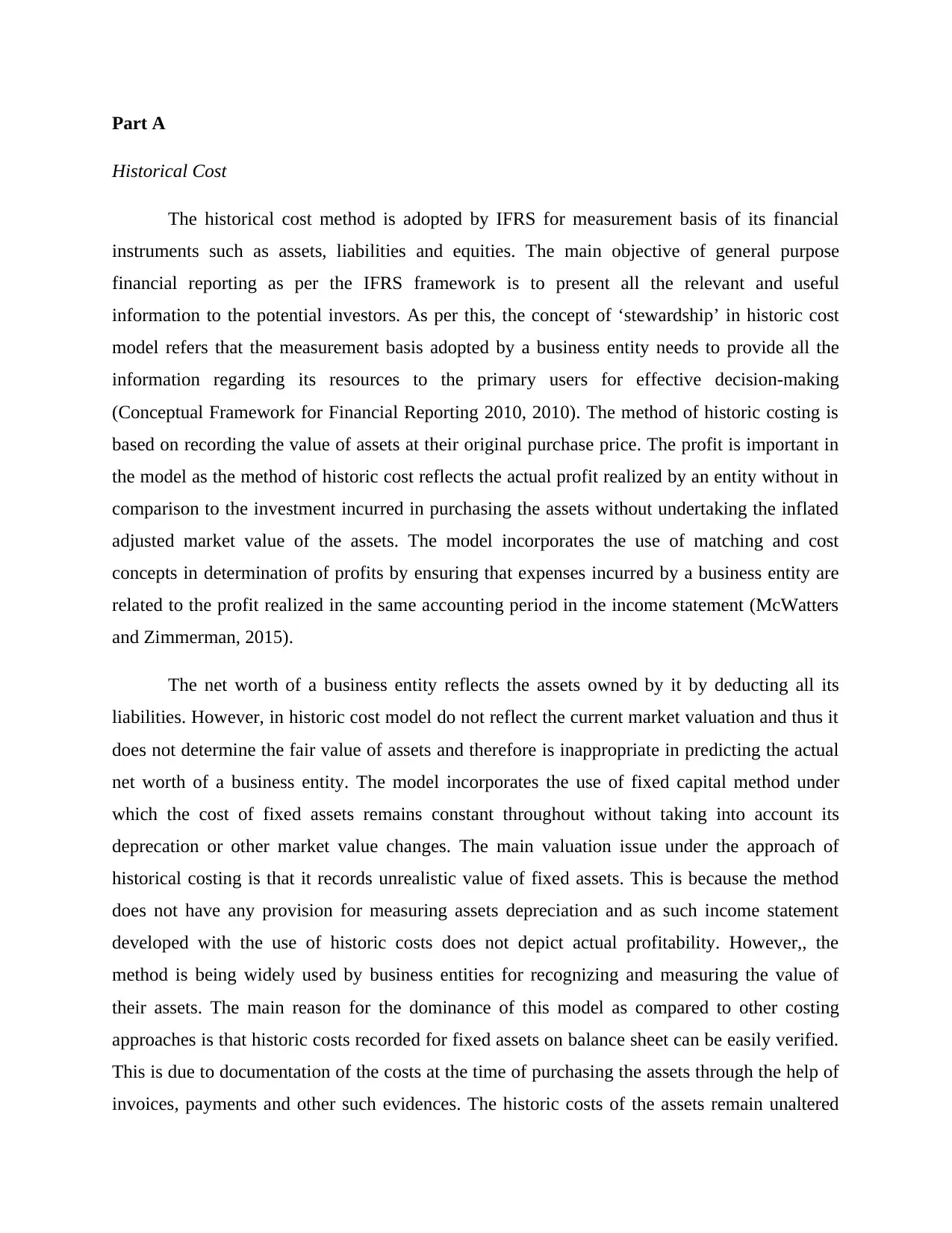
Part A
Historical Cost
The historical cost method is adopted by IFRS for measurement basis of its financial
instruments such as assets, liabilities and equities. The main objective of general purpose
financial reporting as per the IFRS framework is to present all the relevant and useful
information to the potential investors. As per this, the concept of ‘stewardship’ in historic cost
model refers that the measurement basis adopted by a business entity needs to provide all the
information regarding its resources to the primary users for effective decision-making
(Conceptual Framework for Financial Reporting 2010, 2010). The method of historic costing is
based on recording the value of assets at their original purchase price. The profit is important in
the model as the method of historic cost reflects the actual profit realized by an entity without in
comparison to the investment incurred in purchasing the assets without undertaking the inflated
adjusted market value of the assets. The model incorporates the use of matching and cost
concepts in determination of profits by ensuring that expenses incurred by a business entity are
related to the profit realized in the same accounting period in the income statement (McWatters
and Zimmerman, 2015).
The net worth of a business entity reflects the assets owned by it by deducting all its
liabilities. However, in historic cost model do not reflect the current market valuation and thus it
does not determine the fair value of assets and therefore is inappropriate in predicting the actual
net worth of a business entity. The model incorporates the use of fixed capital method under
which the cost of fixed assets remains constant throughout without taking into account its
deprecation or other market value changes. The main valuation issue under the approach of
historical costing is that it records unrealistic value of fixed assets. This is because the method
does not have any provision for measuring assets depreciation and as such income statement
developed with the use of historic costs does not depict actual profitability. However,, the
method is being widely used by business entities for recognizing and measuring the value of
their assets. The main reason for the dominance of this model as compared to other costing
approaches is that historic costs recorded for fixed assets on balance sheet can be easily verified.
This is due to documentation of the costs at the time of purchasing the assets through the help of
invoices, payments and other such evidences. The historic costs of the assets remain unaltered
Historical Cost
The historical cost method is adopted by IFRS for measurement basis of its financial
instruments such as assets, liabilities and equities. The main objective of general purpose
financial reporting as per the IFRS framework is to present all the relevant and useful
information to the potential investors. As per this, the concept of ‘stewardship’ in historic cost
model refers that the measurement basis adopted by a business entity needs to provide all the
information regarding its resources to the primary users for effective decision-making
(Conceptual Framework for Financial Reporting 2010, 2010). The method of historic costing is
based on recording the value of assets at their original purchase price. The profit is important in
the model as the method of historic cost reflects the actual profit realized by an entity without in
comparison to the investment incurred in purchasing the assets without undertaking the inflated
adjusted market value of the assets. The model incorporates the use of matching and cost
concepts in determination of profits by ensuring that expenses incurred by a business entity are
related to the profit realized in the same accounting period in the income statement (McWatters
and Zimmerman, 2015).
The net worth of a business entity reflects the assets owned by it by deducting all its
liabilities. However, in historic cost model do not reflect the current market valuation and thus it
does not determine the fair value of assets and therefore is inappropriate in predicting the actual
net worth of a business entity. The model incorporates the use of fixed capital method under
which the cost of fixed assets remains constant throughout without taking into account its
deprecation or other market value changes. The main valuation issue under the approach of
historical costing is that it records unrealistic value of fixed assets. This is because the method
does not have any provision for measuring assets depreciation and as such income statement
developed with the use of historic costs does not depict actual profitability. However,, the
method is being widely used by business entities for recognizing and measuring the value of
their assets. The main reason for the dominance of this model as compared to other costing
approaches is that historic costs recorded for fixed assets on balance sheet can be easily verified.
This is due to documentation of the costs at the time of purchasing the assets through the help of
invoices, payments and other such evidences. The historic costs of the assets remain unaltered
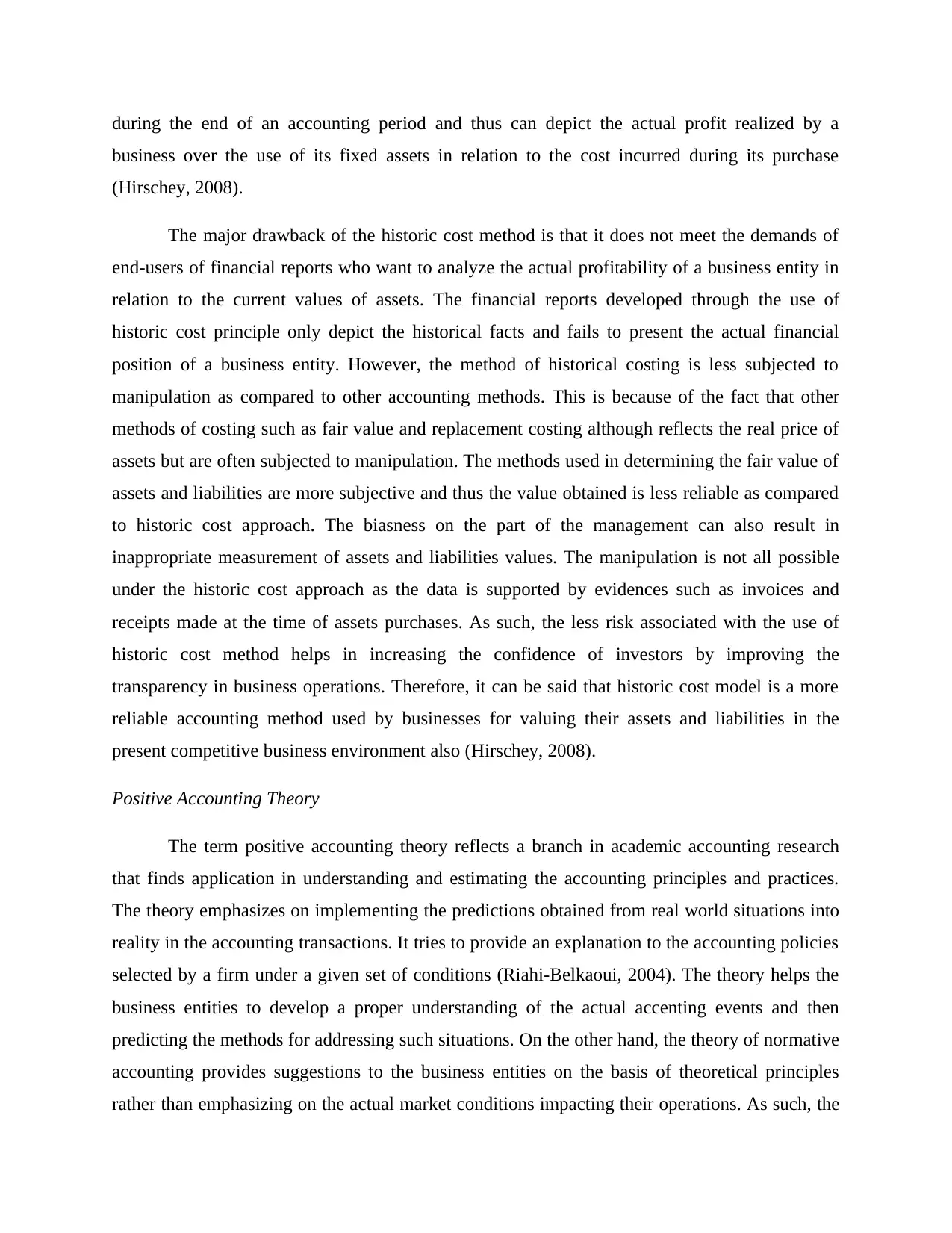
during the end of an accounting period and thus can depict the actual profit realized by a
business over the use of its fixed assets in relation to the cost incurred during its purchase
(Hirschey, 2008).
The major drawback of the historic cost method is that it does not meet the demands of
end-users of financial reports who want to analyze the actual profitability of a business entity in
relation to the current values of assets. The financial reports developed through the use of
historic cost principle only depict the historical facts and fails to present the actual financial
position of a business entity. However, the method of historical costing is less subjected to
manipulation as compared to other accounting methods. This is because of the fact that other
methods of costing such as fair value and replacement costing although reflects the real price of
assets but are often subjected to manipulation. The methods used in determining the fair value of
assets and liabilities are more subjective and thus the value obtained is less reliable as compared
to historic cost approach. The biasness on the part of the management can also result in
inappropriate measurement of assets and liabilities values. The manipulation is not all possible
under the historic cost approach as the data is supported by evidences such as invoices and
receipts made at the time of assets purchases. As such, the less risk associated with the use of
historic cost method helps in increasing the confidence of investors by improving the
transparency in business operations. Therefore, it can be said that historic cost model is a more
reliable accounting method used by businesses for valuing their assets and liabilities in the
present competitive business environment also (Hirschey, 2008).
Positive Accounting Theory
The term positive accounting theory reflects a branch in academic accounting research
that finds application in understanding and estimating the accounting principles and practices.
The theory emphasizes on implementing the predictions obtained from real world situations into
reality in the accounting transactions. It tries to provide an explanation to the accounting policies
selected by a firm under a given set of conditions (Riahi-Belkaoui, 2004). The theory helps the
business entities to develop a proper understanding of the actual accenting events and then
predicting the methods for addressing such situations. On the other hand, the theory of normative
accounting provides suggestions to the business entities on the basis of theoretical principles
rather than emphasizing on the actual market conditions impacting their operations. As such, the
business over the use of its fixed assets in relation to the cost incurred during its purchase
(Hirschey, 2008).
The major drawback of the historic cost method is that it does not meet the demands of
end-users of financial reports who want to analyze the actual profitability of a business entity in
relation to the current values of assets. The financial reports developed through the use of
historic cost principle only depict the historical facts and fails to present the actual financial
position of a business entity. However, the method of historical costing is less subjected to
manipulation as compared to other accounting methods. This is because of the fact that other
methods of costing such as fair value and replacement costing although reflects the real price of
assets but are often subjected to manipulation. The methods used in determining the fair value of
assets and liabilities are more subjective and thus the value obtained is less reliable as compared
to historic cost approach. The biasness on the part of the management can also result in
inappropriate measurement of assets and liabilities values. The manipulation is not all possible
under the historic cost approach as the data is supported by evidences such as invoices and
receipts made at the time of assets purchases. As such, the less risk associated with the use of
historic cost method helps in increasing the confidence of investors by improving the
transparency in business operations. Therefore, it can be said that historic cost model is a more
reliable accounting method used by businesses for valuing their assets and liabilities in the
present competitive business environment also (Hirschey, 2008).
Positive Accounting Theory
The term positive accounting theory reflects a branch in academic accounting research
that finds application in understanding and estimating the accounting principles and practices.
The theory emphasizes on implementing the predictions obtained from real world situations into
reality in the accounting transactions. It tries to provide an explanation to the accounting policies
selected by a firm under a given set of conditions (Riahi-Belkaoui, 2004). The theory helps the
business entities to develop a proper understanding of the actual accenting events and then
predicting the methods for addressing such situations. On the other hand, the theory of normative
accounting provides suggestions to the business entities on the basis of theoretical principles
rather than emphasizing on the actual market conditions impacting their operations. As such, the
⊘ This is a preview!⊘
Do you want full access?
Subscribe today to unlock all pages.

Trusted by 1+ million students worldwide
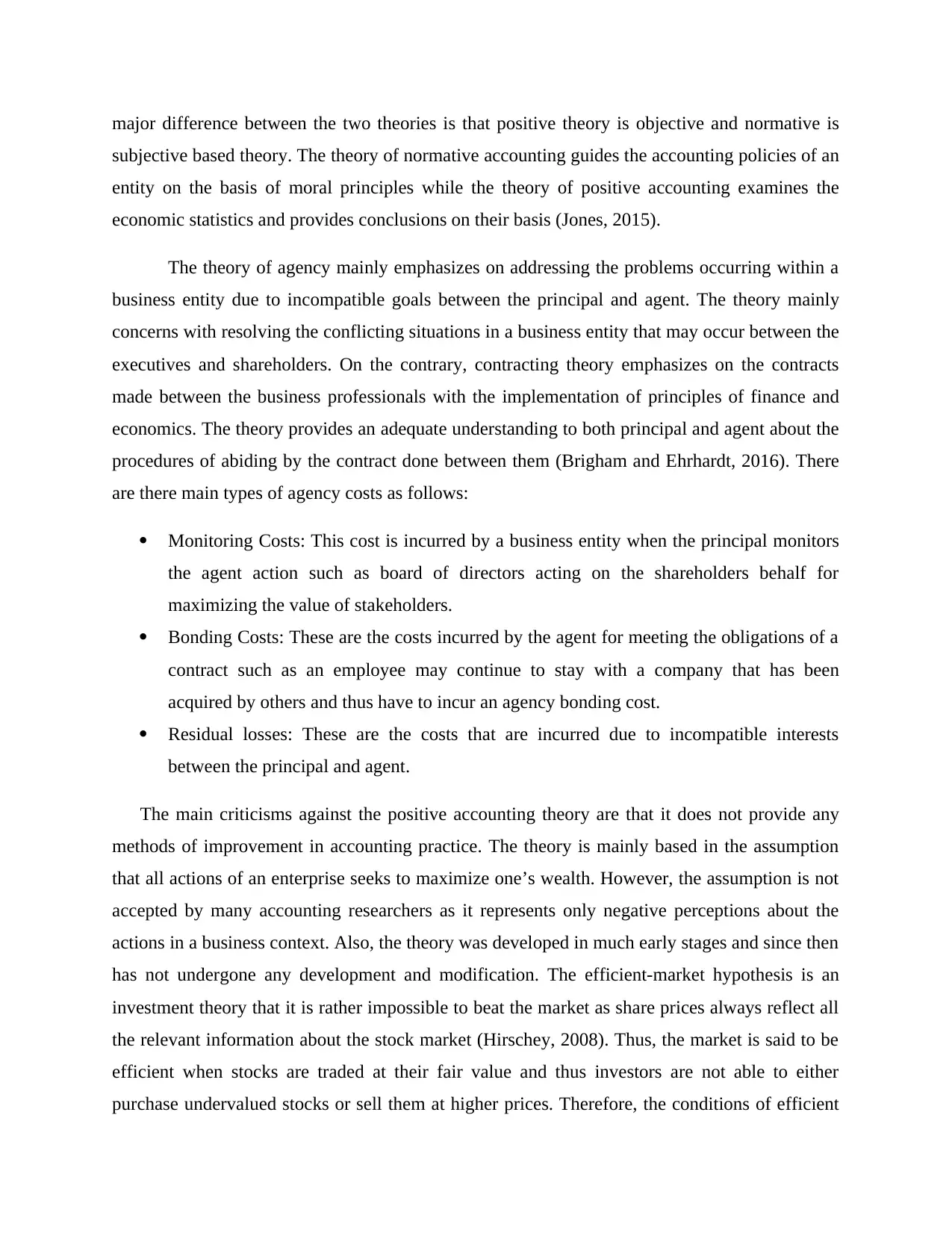
major difference between the two theories is that positive theory is objective and normative is
subjective based theory. The theory of normative accounting guides the accounting policies of an
entity on the basis of moral principles while the theory of positive accounting examines the
economic statistics and provides conclusions on their basis (Jones, 2015).
The theory of agency mainly emphasizes on addressing the problems occurring within a
business entity due to incompatible goals between the principal and agent. The theory mainly
concerns with resolving the conflicting situations in a business entity that may occur between the
executives and shareholders. On the contrary, contracting theory emphasizes on the contracts
made between the business professionals with the implementation of principles of finance and
economics. The theory provides an adequate understanding to both principal and agent about the
procedures of abiding by the contract done between them (Brigham and Ehrhardt, 2016). There
are there main types of agency costs as follows:
Monitoring Costs: This cost is incurred by a business entity when the principal monitors
the agent action such as board of directors acting on the shareholders behalf for
maximizing the value of stakeholders.
Bonding Costs: These are the costs incurred by the agent for meeting the obligations of a
contract such as an employee may continue to stay with a company that has been
acquired by others and thus have to incur an agency bonding cost.
Residual losses: These are the costs that are incurred due to incompatible interests
between the principal and agent.
The main criticisms against the positive accounting theory are that it does not provide any
methods of improvement in accounting practice. The theory is mainly based in the assumption
that all actions of an enterprise seeks to maximize one’s wealth. However, the assumption is not
accepted by many accounting researchers as it represents only negative perceptions about the
actions in a business context. Also, the theory was developed in much early stages and since then
has not undergone any development and modification. The efficient-market hypothesis is an
investment theory that it is rather impossible to beat the market as share prices always reflect all
the relevant information about the stock market (Hirschey, 2008). Thus, the market is said to be
efficient when stocks are traded at their fair value and thus investors are not able to either
purchase undervalued stocks or sell them at higher prices. Therefore, the conditions of efficient
subjective based theory. The theory of normative accounting guides the accounting policies of an
entity on the basis of moral principles while the theory of positive accounting examines the
economic statistics and provides conclusions on their basis (Jones, 2015).
The theory of agency mainly emphasizes on addressing the problems occurring within a
business entity due to incompatible goals between the principal and agent. The theory mainly
concerns with resolving the conflicting situations in a business entity that may occur between the
executives and shareholders. On the contrary, contracting theory emphasizes on the contracts
made between the business professionals with the implementation of principles of finance and
economics. The theory provides an adequate understanding to both principal and agent about the
procedures of abiding by the contract done between them (Brigham and Ehrhardt, 2016). There
are there main types of agency costs as follows:
Monitoring Costs: This cost is incurred by a business entity when the principal monitors
the agent action such as board of directors acting on the shareholders behalf for
maximizing the value of stakeholders.
Bonding Costs: These are the costs incurred by the agent for meeting the obligations of a
contract such as an employee may continue to stay with a company that has been
acquired by others and thus have to incur an agency bonding cost.
Residual losses: These are the costs that are incurred due to incompatible interests
between the principal and agent.
The main criticisms against the positive accounting theory are that it does not provide any
methods of improvement in accounting practice. The theory is mainly based in the assumption
that all actions of an enterprise seeks to maximize one’s wealth. However, the assumption is not
accepted by many accounting researchers as it represents only negative perceptions about the
actions in a business context. Also, the theory was developed in much early stages and since then
has not undergone any development and modification. The efficient-market hypothesis is an
investment theory that it is rather impossible to beat the market as share prices always reflect all
the relevant information about the stock market (Hirschey, 2008). Thus, the market is said to be
efficient when stocks are traded at their fair value and thus investors are not able to either
purchase undervalued stocks or sell them at higher prices. Therefore, the conditions of efficient
Paraphrase This Document
Need a fresh take? Get an instant paraphrase of this document with our AI Paraphraser

market make it impossible for outperforming the market and thus expecting higher gains by
investing money in risky stocks and assets. In this context, the weak form of EMH also known as
random-walk theory states that in the conditions of market efficiency, the past rate of return is
independent of the future return. On the other hand, semi-strong of efficient market hypothesis
states that share prices quickly absorb new information available in the market and thus investors
cannot realize higher rate of return on a stock by beating the market conditions. At last, the
strong-form of efficient-market hypothesis states that in the condition of efficiency, the share
prices reflect all the public and private information and thus covering both weak and semi-strong
form of EMH (McWatters and Zimmerman, 2015).
Part B
The concept of capital maintenance emphasizes on the method adopts by a business
entity for developing its capital structure in order to provide return on capital to its shareholders.
The IASB (International Accounting Standards Board) has identified and developed two
concepts of capital that are, a finance concept and a physical concept (Conceptual Framework for
Financial Reporting 2010). The finance concept of capital refers to an entity capital that is
developed by mainly the equity resources. The profit is earned on the capital only if the net
amount of assets at the end of a financial year is greater than the net assets at the beginning
(Henderson, 2015). The finance concept of capital maintenance incorporates the use of following
formula for calculating the equity capital:
Equity=Assets-Liability
The method also adopts the use of two approaches for maintaining the financial capital
that are money capital and real financial capital maintenance. The concept of money capital
maintenance measures profit when the closing amount of net assets is more than the net assets at
the beginning of the period by using the historical cost accounting method. The method does not
incorporate the impact of inflation or the concept of time value of money. However, the method
of real financial capital maintenance for measuring profit calculates the amount of net assets at
the end of the period to that of beginning but using the fair value accounting approach (Brigham
and Ehrhardt, 2016).
investing money in risky stocks and assets. In this context, the weak form of EMH also known as
random-walk theory states that in the conditions of market efficiency, the past rate of return is
independent of the future return. On the other hand, semi-strong of efficient market hypothesis
states that share prices quickly absorb new information available in the market and thus investors
cannot realize higher rate of return on a stock by beating the market conditions. At last, the
strong-form of efficient-market hypothesis states that in the condition of efficiency, the share
prices reflect all the public and private information and thus covering both weak and semi-strong
form of EMH (McWatters and Zimmerman, 2015).
Part B
The concept of capital maintenance emphasizes on the method adopts by a business
entity for developing its capital structure in order to provide return on capital to its shareholders.
The IASB (International Accounting Standards Board) has identified and developed two
concepts of capital that are, a finance concept and a physical concept (Conceptual Framework for
Financial Reporting 2010). The finance concept of capital refers to an entity capital that is
developed by mainly the equity resources. The profit is earned on the capital only if the net
amount of assets at the end of a financial year is greater than the net assets at the beginning
(Henderson, 2015). The finance concept of capital maintenance incorporates the use of following
formula for calculating the equity capital:
Equity=Assets-Liability
The method also adopts the use of two approaches for maintaining the financial capital
that are money capital and real financial capital maintenance. The concept of money capital
maintenance measures profit when the closing amount of net assets is more than the net assets at
the beginning of the period by using the historical cost accounting method. The method does not
incorporate the impact of inflation or the concept of time value of money. However, the method
of real financial capital maintenance for measuring profit calculates the amount of net assets at
the end of the period to that of beginning but using the fair value accounting approach (Brigham
and Ehrhardt, 2016).
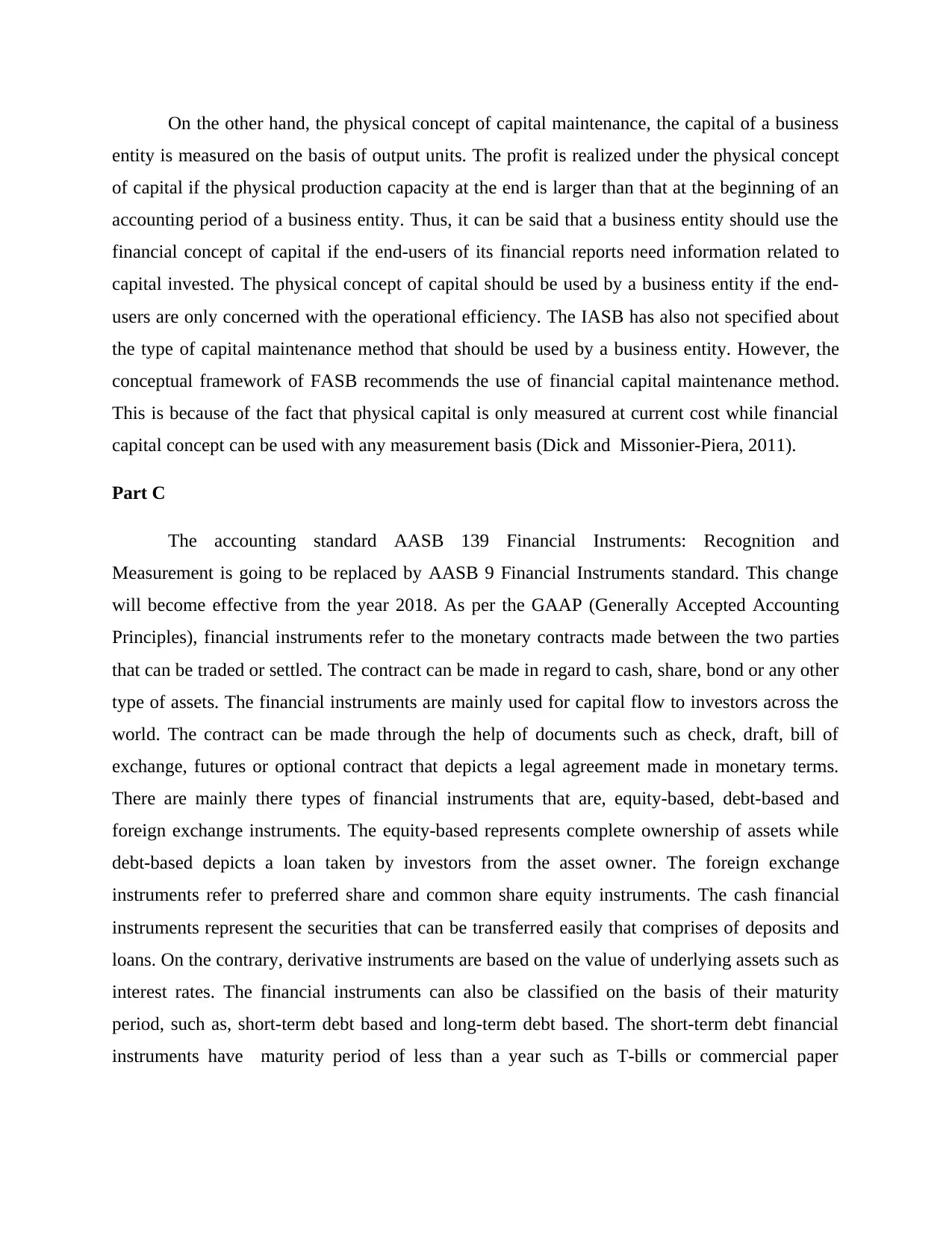
On the other hand, the physical concept of capital maintenance, the capital of a business
entity is measured on the basis of output units. The profit is realized under the physical concept
of capital if the physical production capacity at the end is larger than that at the beginning of an
accounting period of a business entity. Thus, it can be said that a business entity should use the
financial concept of capital if the end-users of its financial reports need information related to
capital invested. The physical concept of capital should be used by a business entity if the end-
users are only concerned with the operational efficiency. The IASB has also not specified about
the type of capital maintenance method that should be used by a business entity. However, the
conceptual framework of FASB recommends the use of financial capital maintenance method.
This is because of the fact that physical capital is only measured at current cost while financial
capital concept can be used with any measurement basis (Dick and Missonier-Piera, 2011).
Part C
The accounting standard AASB 139 Financial Instruments: Recognition and
Measurement is going to be replaced by AASB 9 Financial Instruments standard. This change
will become effective from the year 2018. As per the GAAP (Generally Accepted Accounting
Principles), financial instruments refer to the monetary contracts made between the two parties
that can be traded or settled. The contract can be made in regard to cash, share, bond or any other
type of assets. The financial instruments are mainly used for capital flow to investors across the
world. The contract can be made through the help of documents such as check, draft, bill of
exchange, futures or optional contract that depicts a legal agreement made in monetary terms.
There are mainly there types of financial instruments that are, equity-based, debt-based and
foreign exchange instruments. The equity-based represents complete ownership of assets while
debt-based depicts a loan taken by investors from the asset owner. The foreign exchange
instruments refer to preferred share and common share equity instruments. The cash financial
instruments represent the securities that can be transferred easily that comprises of deposits and
loans. On the contrary, derivative instruments are based on the value of underlying assets such as
interest rates. The financial instruments can also be classified on the basis of their maturity
period, such as, short-term debt based and long-term debt based. The short-term debt financial
instruments have maturity period of less than a year such as T-bills or commercial paper
entity is measured on the basis of output units. The profit is realized under the physical concept
of capital if the physical production capacity at the end is larger than that at the beginning of an
accounting period of a business entity. Thus, it can be said that a business entity should use the
financial concept of capital if the end-users of its financial reports need information related to
capital invested. The physical concept of capital should be used by a business entity if the end-
users are only concerned with the operational efficiency. The IASB has also not specified about
the type of capital maintenance method that should be used by a business entity. However, the
conceptual framework of FASB recommends the use of financial capital maintenance method.
This is because of the fact that physical capital is only measured at current cost while financial
capital concept can be used with any measurement basis (Dick and Missonier-Piera, 2011).
Part C
The accounting standard AASB 139 Financial Instruments: Recognition and
Measurement is going to be replaced by AASB 9 Financial Instruments standard. This change
will become effective from the year 2018. As per the GAAP (Generally Accepted Accounting
Principles), financial instruments refer to the monetary contracts made between the two parties
that can be traded or settled. The contract can be made in regard to cash, share, bond or any other
type of assets. The financial instruments are mainly used for capital flow to investors across the
world. The contract can be made through the help of documents such as check, draft, bill of
exchange, futures or optional contract that depicts a legal agreement made in monetary terms.
There are mainly there types of financial instruments that are, equity-based, debt-based and
foreign exchange instruments. The equity-based represents complete ownership of assets while
debt-based depicts a loan taken by investors from the asset owner. The foreign exchange
instruments refer to preferred share and common share equity instruments. The cash financial
instruments represent the securities that can be transferred easily that comprises of deposits and
loans. On the contrary, derivative instruments are based on the value of underlying assets such as
interest rates. The financial instruments can also be classified on the basis of their maturity
period, such as, short-term debt based and long-term debt based. The short-term debt financial
instruments have maturity period of less than a year such as T-bills or commercial paper
⊘ This is a preview!⊘
Do you want full access?
Subscribe today to unlock all pages.

Trusted by 1+ million students worldwide

whereas long-term debt based instruments have a maturity of more than a year such as bonds and
loans (Weiss, 2009).
The new AASB 9 standard has simplified the recognition and measurement basis for
financial instruments. It will prove to be largely beneficial for hedging and risk management of
business entities. As per the standard, hedged items of a business entity are recognized assets or
liability, future transactions or investment options in foreign countries. The standard advocates
that all the financial instruments will be recognized and measured on their fair value or at
amortized cost. The financial assets will be measured at their amortized cost only on meeting of
certain conditions otherwise all assets will be recognized at their fair value. The impairment
model as per the new standard is based on expected loss criteria rather than on incurred loss
model (McWatters and Zimmerman, 2015).
The standard has relatively simplified the implementation of hedge accounting concept
by business entities of Australia and has enhanced the use of options as a hedging instrument.
The new standard has also promoted the hedging of benchmark pricing components of
commodity contracts such as crude oil, jet fuel or diesel and iron ores. However, the
classification and measurement of financial liabilities as per the new standards are based on
previous AASB 139 standards. The only difference is that any gain or losses realized on the
financial liabilities are stated in the profit or loss statements. The new standards will provide
great help to the business entities regarding the adoption of hedge accounting by removing the
threshold of 80-125% and thus enabling the qualifying criteria of many items for hedging. Thus,
the new AASB 9 standard effective from the year 2018 will help the business entities operating
in Australia to effectively manage their interest rate, foreign exchange and commodity price risks
(Dagwell, Wines and Lambert, 2015).
loans (Weiss, 2009).
The new AASB 9 standard has simplified the recognition and measurement basis for
financial instruments. It will prove to be largely beneficial for hedging and risk management of
business entities. As per the standard, hedged items of a business entity are recognized assets or
liability, future transactions or investment options in foreign countries. The standard advocates
that all the financial instruments will be recognized and measured on their fair value or at
amortized cost. The financial assets will be measured at their amortized cost only on meeting of
certain conditions otherwise all assets will be recognized at their fair value. The impairment
model as per the new standard is based on expected loss criteria rather than on incurred loss
model (McWatters and Zimmerman, 2015).
The standard has relatively simplified the implementation of hedge accounting concept
by business entities of Australia and has enhanced the use of options as a hedging instrument.
The new standard has also promoted the hedging of benchmark pricing components of
commodity contracts such as crude oil, jet fuel or diesel and iron ores. However, the
classification and measurement of financial liabilities as per the new standards are based on
previous AASB 139 standards. The only difference is that any gain or losses realized on the
financial liabilities are stated in the profit or loss statements. The new standards will provide
great help to the business entities regarding the adoption of hedge accounting by removing the
threshold of 80-125% and thus enabling the qualifying criteria of many items for hedging. Thus,
the new AASB 9 standard effective from the year 2018 will help the business entities operating
in Australia to effectively manage their interest rate, foreign exchange and commodity price risks
(Dagwell, Wines and Lambert, 2015).
Paraphrase This Document
Need a fresh take? Get an instant paraphrase of this document with our AI Paraphraser
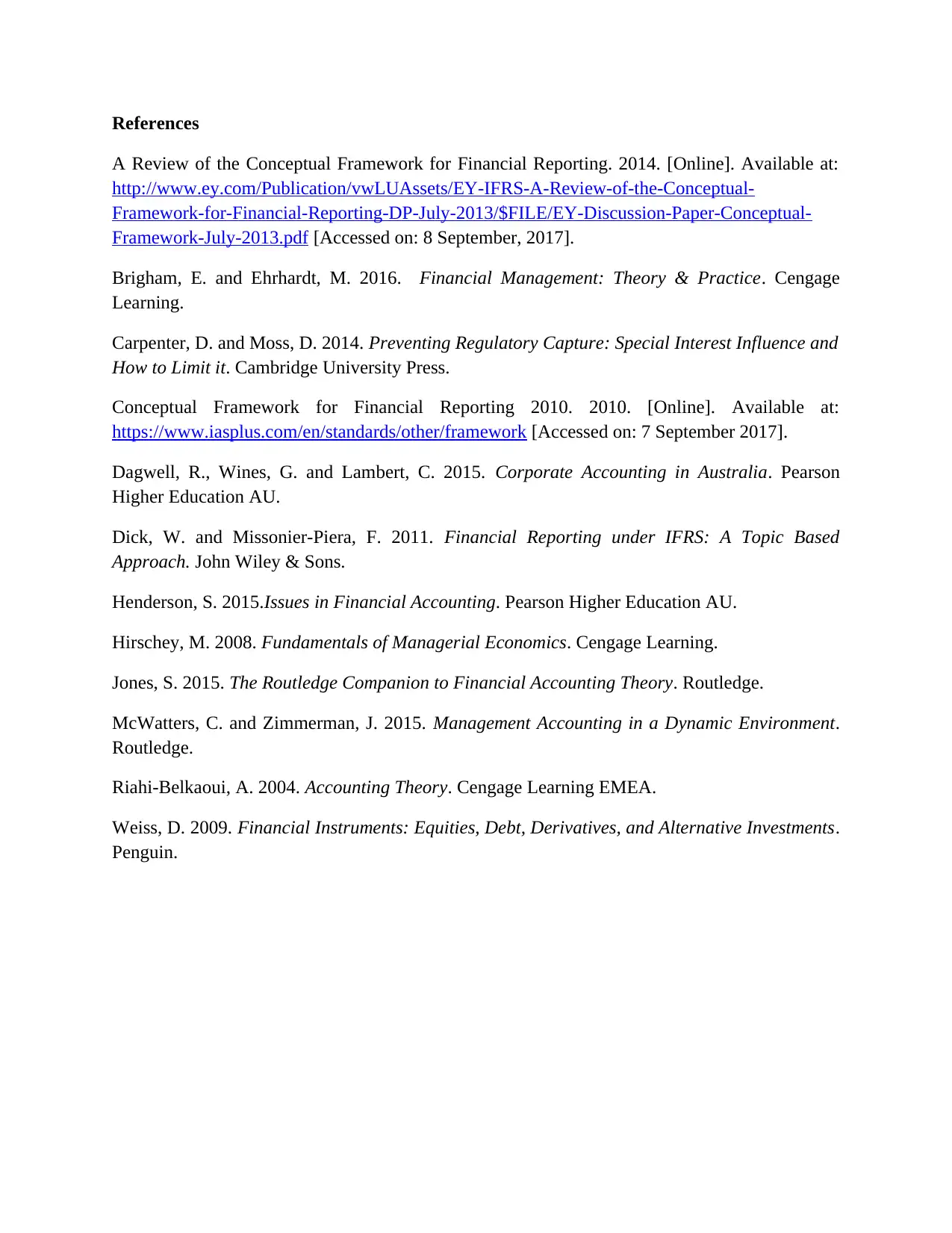
References
A Review of the Conceptual Framework for Financial Reporting. 2014. [Online]. Available at:
http://www.ey.com/Publication/vwLUAssets/EY-IFRS-A-Review-of-the-Conceptual-
Framework-for-Financial-Reporting-DP-July-2013/$FILE/EY-Discussion-Paper-Conceptual-
Framework-July-2013.pdf [Accessed on: 8 September, 2017].
Brigham, E. and Ehrhardt, M. 2016. Financial Management: Theory & Practice. Cengage
Learning.
Carpenter, D. and Moss, D. 2014. Preventing Regulatory Capture: Special Interest Influence and
How to Limit it. Cambridge University Press.
Conceptual Framework for Financial Reporting 2010. 2010. [Online]. Available at:
https://www.iasplus.com/en/standards/other/framework [Accessed on: 7 September 2017].
Dagwell, R., Wines, G. and Lambert, C. 2015. Corporate Accounting in Australia. Pearson
Higher Education AU.
Dick, W. and Missonier-Piera, F. 2011. Financial Reporting under IFRS: A Topic Based
Approach. John Wiley & Sons.
Henderson, S. 2015.Issues in Financial Accounting. Pearson Higher Education AU.
Hirschey, M. 2008. Fundamentals of Managerial Economics. Cengage Learning.
Jones, S. 2015. The Routledge Companion to Financial Accounting Theory. Routledge.
McWatters, C. and Zimmerman, J. 2015. Management Accounting in a Dynamic Environment.
Routledge.
Riahi-Belkaoui, A. 2004. Accounting Theory. Cengage Learning EMEA.
Weiss, D. 2009. Financial Instruments: Equities, Debt, Derivatives, and Alternative Investments.
Penguin.
A Review of the Conceptual Framework for Financial Reporting. 2014. [Online]. Available at:
http://www.ey.com/Publication/vwLUAssets/EY-IFRS-A-Review-of-the-Conceptual-
Framework-for-Financial-Reporting-DP-July-2013/$FILE/EY-Discussion-Paper-Conceptual-
Framework-July-2013.pdf [Accessed on: 8 September, 2017].
Brigham, E. and Ehrhardt, M. 2016. Financial Management: Theory & Practice. Cengage
Learning.
Carpenter, D. and Moss, D. 2014. Preventing Regulatory Capture: Special Interest Influence and
How to Limit it. Cambridge University Press.
Conceptual Framework for Financial Reporting 2010. 2010. [Online]. Available at:
https://www.iasplus.com/en/standards/other/framework [Accessed on: 7 September 2017].
Dagwell, R., Wines, G. and Lambert, C. 2015. Corporate Accounting in Australia. Pearson
Higher Education AU.
Dick, W. and Missonier-Piera, F. 2011. Financial Reporting under IFRS: A Topic Based
Approach. John Wiley & Sons.
Henderson, S. 2015.Issues in Financial Accounting. Pearson Higher Education AU.
Hirschey, M. 2008. Fundamentals of Managerial Economics. Cengage Learning.
Jones, S. 2015. The Routledge Companion to Financial Accounting Theory. Routledge.
McWatters, C. and Zimmerman, J. 2015. Management Accounting in a Dynamic Environment.
Routledge.
Riahi-Belkaoui, A. 2004. Accounting Theory. Cengage Learning EMEA.
Weiss, D. 2009. Financial Instruments: Equities, Debt, Derivatives, and Alternative Investments.
Penguin.

⊘ This is a preview!⊘
Do you want full access?
Subscribe today to unlock all pages.

Trusted by 1+ million students worldwide
1 out of 9
Related Documents
Your All-in-One AI-Powered Toolkit for Academic Success.
+13062052269
info@desklib.com
Available 24*7 on WhatsApp / Email
![[object Object]](/_next/static/media/star-bottom.7253800d.svg)
Unlock your academic potential
Copyright © 2020–2025 A2Z Services. All Rights Reserved. Developed and managed by ZUCOL.





